Giving in Crypto Boomed in 2021

In 2021, payments processor The Giving Block partnered with 958 new non-profit organizations and helped raised more than $69 million for these charities through crypto donations. The largest grant maker in the U.S., Fidelity Charitable, also reports record-breaking figures, having received $331m in crypto donations in 2021. As a proxy for some of the most important industry trends, the rise of giving in bitcoin and other digital assets is an important and relevant metrics for investors to follow.
Key Takeaways
2021 proved to be the biggest year for crypto donations, with $331m in crypto donated to Fidelity Charitable, the largest grant maker in the U.S. The number of registered charities accepting crypto donations is skyrocketing. The Giving Block reports that for its annual fundraising event, #CryptoGivingTuesday, the number of participating non-profits grew 839% in 2021 compared to the prior year.
The crypto giving landscape can be broadly categorized into two sectors: charitable giving for registered non-profits and philanthropic funding for distributed organizations.
The shift from predominantly BTC-denominated donations to ETH-denominated donations to The Giving Block in 2021 is indicative of growing retail adoption of Ethereum. The growing value managed by grants DAOs to facilitate funding of public goods shows increasing experimentation with blockchain technology to streamline and decentralize aspects of charitable giving.
Introduction
The total value of donations contributed in cryptocurrencies to registered charities and public goods funding platforms in the U.S. hit new all-time highs in 2021. Fidelity Charitable, the largest charity in the U.S., raised $331m crypto over the entirety of 2021. The prior record for crypto donations to Fidelity Charitable set in 2017 was less than a quarter of this amount. According to donation-focused payments processor The Giving Block, the number of nonprofits accepting cryptocurrency donations also increased 10x from 2020 to 2021, from roughly 100 organizations to over 1,000.
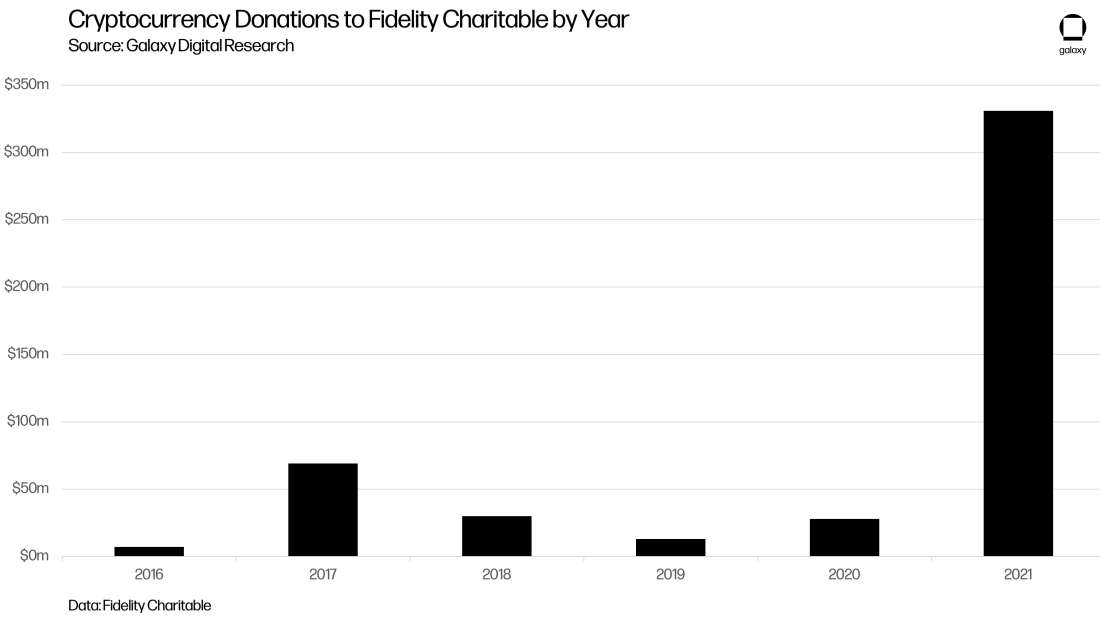
The increasing volume of crypto charity donations and the growing list of participating non-profit organizations is indicative of three industry trends:
First, a rise in crypto donations suggests growing adoption of cryptocurrencies among a sophisticated and professional class of investors. It’s not a coincidence that during the year in which bitcoin saw the most institutional adoption, the amount of crypto donations skyrocketed to an all-time high. By donating cryptocurrencies, investors can offset capital gains taxes and enable the possibility of a bigger check amount to a non-profit than if they had used out-of-pocket funds. More than half of all clients giving in cryptocurrencies at Fidelity Charitable have reported tax benefits and asset appreciation as their motivation for donating in 2021.
Second, a rise in crypto donations marks a shift in general donor demographics, meaning the type of individuals seen as the most likely to engage in charitable giving. Outside of crypto, the average donor in the nonprofit sector is 64, while the average age of crypto users is 38. In addition, according to the Giving Block, the average crypto donation is 82 times higher in dollar value than the average online donation. These figures suggest that crypto donors are markedly different from the traditional donor profile in that they are younger and possess a higher on average income. The growing number of younger donors giving higher dollar amounts in crypto highlights a new target demographic for charities and non-profits to strategize around, as well as engage with.
Finally, a rise in crypto donations is indicative of growing mainstream acceptance for cryptocurrencies. Approximately 21 million Americans, which is 14% of the U.S. population, are invested in cryptocurrencies as of May 2021. For years since the creation of bitcoin, the world’s first and most valuable cryptocurrency, the most common argument against the long-term adoption of the asset class was its volatility. Bitcoin critics would and still do point to the fact that the market value of the asset fluctuates so sharply that its use case as a peer-to-peer payments rail or digital gold cannot be taken seriously. Yet, a growing number of not only risk-hungry investors but risk-averse charities are beginning to build and rely on infrastructure to support cryptocurrencies as a legitimate financial asset with a variety of potential use cases, one of which being a form of payment.
Within the broad category of crypto donations, there are two main types of giving: charitable giving for registered non-profits and philanthropic funding for distributed organizations. Facilitating funding within both categories are intermediary payments processors and decentralized autonomous organizations (DAOs).
Cryptocurrency Giving Landscape
The first international non-governmental organization to accept a crypto donation was Save the Children. In response to a natural disaster in the Philippines during 2013, the NGO set up a fundraising goal of $30 million and partnered with bitcoin payment processor Bitpay to accept donations in BTC. Since then, over 1,000 non-profits organizations including the United Way, American Cancer Society, and the International Medical Corps have started to accept bitcoin, along with ether, litecoin, USDC and a slew of other altcoins.
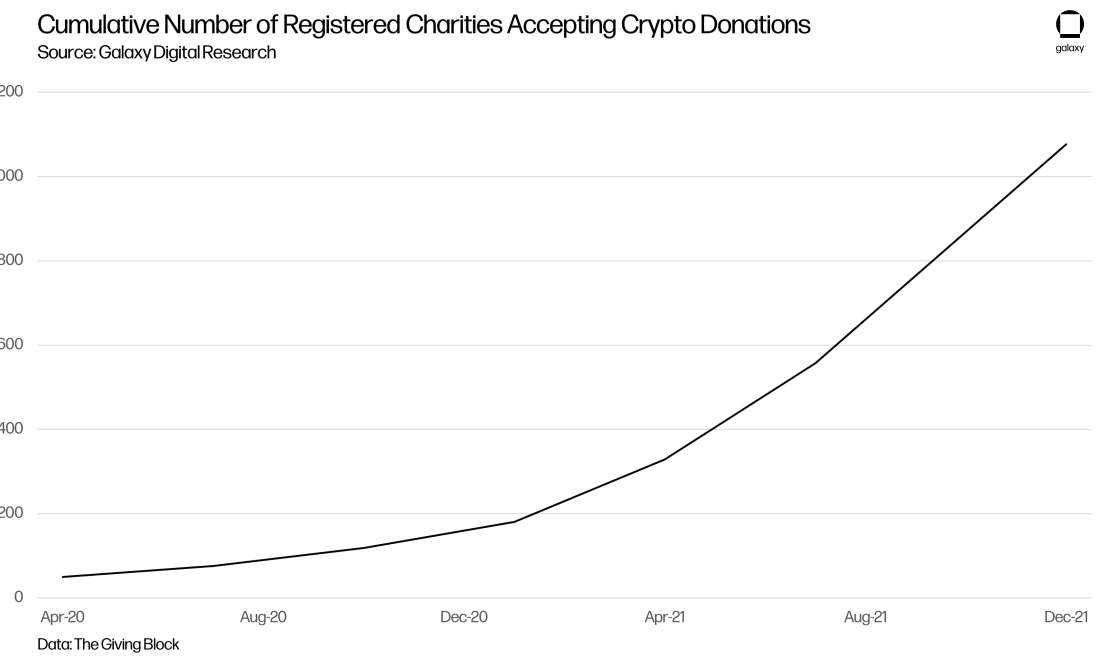
Cryptocurrencies have also been used to fund social and political activism around the world since as early as 2014. In the U.S., several politicians from both the Democratic and Republican parties have accepted crypto donations for their political campaigns. In most cases, crypto is one of several payments options that a donor can choose from when making their financial contribution to a political campaign, non-profit, or registered charity. However, one of the unique advantages of fundraising in crypto that grassroots activist groups are drawn to is the censorship-resistant qualities of sending and receiving crypto contributions.
In October 2020, nation-wide protests broke out against the brutal and abusive practices of a Nigerian police division known as the Special Anti-Robbery Squad. As the demonstrations grew, the bank accounts of known protestors were shut down by government authorities. This caused one of the main groups organizing protests called The Feminist Coalition to turn to bitcoin as an alternative means for raising funds and keeping the movement alive. The Feminist Coalition raised over $150,000 in bitcoin through a self-hosted, open-source bitcoin payments processor BTCPay Server.
Most recently, in 2022, a group of Canadian truckers called the ‘Freedom Convoy’ protesting the end of COVID restrictions in the country was denied access to $7.8 million raised on fundraising platform, GoFundMe, after the platform accused the cohort of engaging in unlawful activities. In need of an alternative, the truckers turned to Bitcoin-based donations processor Tallycoin and have raised more than 21 BTC, worth over $900,000.
Apart from giving for humanitarian and political causes, cryptocurrencies are often relied on as a means of fundraising for the development and maintenance of public blockchains. Blockchains such as Bitcoin and Ethereum are not operated by a single organization and rely on the distributed contributions of voluntary users to secure, develop, and grow the value of the platform. As such, philanthropic funding for these networks may go towards the creation of decentralized applications, wallet services, protocol-level upgrades, and code bounties.
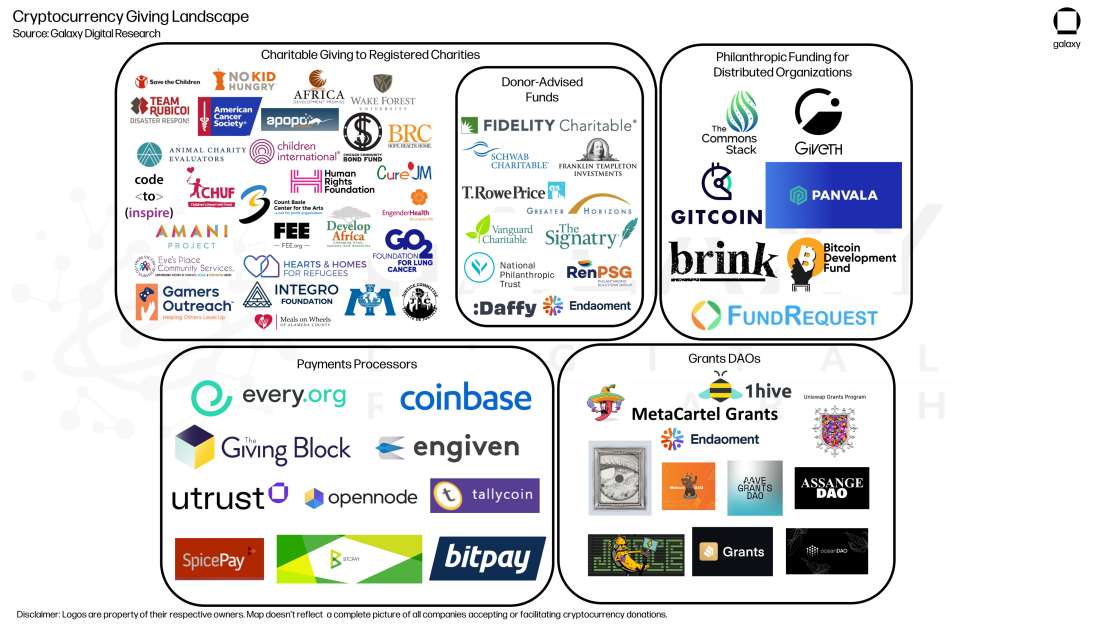
Most registered non-profits work with centralized payments processors such as BitPay and The Giving Block accept cryptocurrencies without having to physically hold or custody any coins. Crypto donations are immediately converted into fiat and added to the balance sheets of these organizations. The benefit of using a payments processor is that charities do not have to invest in their own infrastructure to custody, send, or receive coins, or worry about the regulatory implications of transacting with cryptocurrencies.
On the other hand, using a centralized payments processor requires trusting a third party to hold and distribute funds. As explained, this can pose a risk to certain activist groups who fear losing access to funds due to opposition by government authorities. While charities can bypass relying on a payments processor by setting up their own self-custodied crypto wallets, there are also specialized platforms run by self-executing code known as smart contracts that can facilitate charitable donations directly through the blockchain.
These platforms known as decentralized autonomous organizations (DAOs) are built on general purpose blockchains such as Ethereum and are used to organize a variety of social activities, not just charitable giving. A few popular examples of DAOs that specialize in crowdfunding, also called “grant DAOs,” include Moloch DAO, Juicebox DAO, FreeRoss DAO, Aave Grants DAO, and Endaoment. Read our report on DAOs for an excellent deep dive into this emerging form of online community organization.
Grants DAOs
The degree to which a grants DAO functions independently from a centralized source of funding or by the will of a centralized group of token holders varies from organization to organization. However, one of the overarching benefits of using DAOs for organizing charitable giving is the enhanced transparency for donors to be able to track the activities of the organization, especially the movement of funds, through on-chain analytics.
In addition, as discussed, raising funds directly through the blockchain ensures that the balance is resistant against seizure by governments and law enforcement. This is an important feature of cause-focused grants DAOs that are raising capital for controversial and highly politicized movements or individuals. For example, the Assange DAO which raised $53 million in ETH over the span of a week in February 2022 is fundraising a legal defense fund and awareness campaign for government whistleblower and WikiLeaks founder Julian Assange.
Grants DAOs dedicated to a singular cause such as the Assange DAO often rely on more general-purpose DAO platforms to easily create and fundraise for their projects. Juicebox DAO and MolochDAO are two decentralized applications on Ethereum that facilitate multiple grants across a broad range of causes from blockchain protocol development to political activism. MolochDAO, which currently manages close to $7 million in crypto assets, is named after a deity in the Hebrew Bible that accepted costly sacrifices from its worshippers. The name is meant to highlight the DAO’s attempt to solve the free-rider problem to funding public goods and encourage crypto natives to donate (a “costly sacrifice”) to support open-source development.
In traditional economics, public goods are theorized to be underfunded due to the difficulty in coordinating a large group of community members to act cohesively for a commodity or service with marginal individual benefit but high collective benefits. A mechanism of MolochDAO that tries to address the coordination cost of public goods by making it extremely easy for members of the DAO to express dissent is the “ragequit” function. After the voting for a fundraising proposal has closed, members of MolochDAO have a 7-day period to withdraw their funds and liquidate their voting power to fund alternative endeavors without penalty.
By automating and streamlining the process for accepting crypto donations, evaluating proposals for public goods funding, voting on them, and expressing dissent against them, grants DAOs like MolochDAO are actively experimenting with ways to revolutionize aspects of charitable giving through decentralization.
Using payments processors and grants DAOs, cryptocurrency holders are giving primarily to registered charities and blockchain development communities. Starting with registered charities, the next section of this report will discuss the motivations for these two types of giving.
Charitable Giving to Registered Non-Profits
Charitable giving as defined by the U.S. Internal Revenue Service (IRS) is a voluntary donation or gift made to a registered non-profit organization without receiving, or expecting to receive, back anything of equal value. While non-profits are traditionally thought of as a group advancing a single cause, be it religious, humanitarian, educational, scientific, or literary, a non-profit can also be a separately identified fund or account that is maintained and operated by organizations known as donor advised funds (DAFs), which were created to maximize charitable giving across several causes.
DAFs such as Fidelity Charitable and Schwab Charitable are usually tied to a larger financial institution and accept a wide range of instruments for donations, ranging from equities to crypto and even alternatives like real estate and aircraft. Some donations can be held and continue to appreciate until the donor directs them to a charity, while others such as cryptocurrencies are often liquidated immediately and held in cash or reinvested in Fidelity Investment products and funds until the point of donation. For crypto holders, donating crypto is often more advantageous for tax purposes than donating fiat.
In the U.S., cryptocurrencies are treated as property for tax purposes and may be subject to capital gains taxes when converted into fiat. In general, a capital gains tax applies on a sale of property on the difference between the proceeds received on the sale and the amount originally spent to purchase the asset, assuming the proceeds received is greater than the amount spent to purchase the asset. The higher an asset appreciates in value over time, the greater the potential capital gains tax on a future sale.
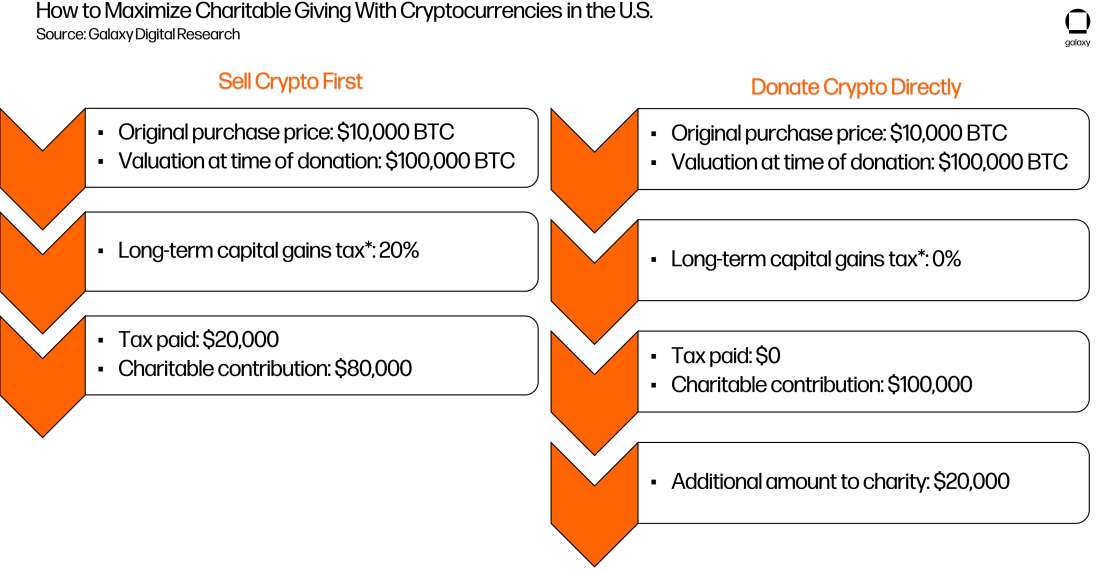
Given the volatility of cryptocurrencies, investors may find it especially beneficial to mitigate capital gains taxes on their appreciated cryptocurrency positions by donating all or a portion of their appreciated cryptocurrencies to a registered non-profit organization or DAF. In addition to mitigating capital gains tax, investors may be entitled to a charitable donation deduction equal to the fair market value of the cryptocurrency/cryptocurrencies at the time of donation which can be used to reduce their federal income tax liability, subject to limitations based on their adjusted gross income. For these benefits to kick-in, however, investors must have held their appreciated cryptocurrencies for at least 1 year and transfer them directly to a registered non-profit organization or DAF without any conversions to another cryptocurrency or fiat prior to such transfer.
In addition to the general rules described above, investors who are considering donating appreciated cryptocurrencies should also consider potential valuation and appraisal requirements. Charitable contributions of property which result in a deduction of more than $5,000 requires an appraisal by a qualified professional. The fee for appraisal can range anywhere from $100 to $600, which is important when deciding whether to make a charitable donation. DAFs are typically well-resourced, employ or have their own appraisers, and have experts for evaluating the tax benefits of charitable donations and processing these donations at opportune times on behalf of investors, but donating via other methods may require a more complicated appraisal process.
It is important to note that the general rules described above don’t apply for charitable contributions to political campaigns. It also does not apply to DAOs unless the DAO is a qualified organization (or registered non-profit organization). The Endaoment DAO is one such organization as the company that operates and maintains the Endaoment DAO holds a license to function as a registered DAF, making charitable contributions to its DAO potentially beneficial for tax purposes
Philanthropic Funding to Distributed Organizations
Apart from registered charities, cryptocurrency donations are often initiated to fund blockchain protocol development and ecosystem growth. Rather than humanitarian needs, these donations are focused on contributing towards commodities or services for the edification of all users on a public blockchain. Like charitable giving, cryptocurrency donations for blockchain public goods are contributed without the expectation of personal profit which disqualifies funding into initial coin offerings (ICOs) and other similar types of tokens sales from being considered as a crypto donation.
Gitcoin is one of the most popular platforms for giving in crypto to fund blockchain protocol development and has financed several crypto hackathons, mentorship programs, research, and developer salaries. Launched back in November 2017, the company formally named Gitcoin Holdings Inc. and incorporated in Delaware has allocated close to $50 million in funding for various public goods in the crypto space and progressed research on how to make public goods funding more sustainable by experimenting with novel strategies for distributing donor contributions such as quadratic funding. Over time, the platform is expected to decentralize and steadily transition into funding public goods through self-executing smart contract code.
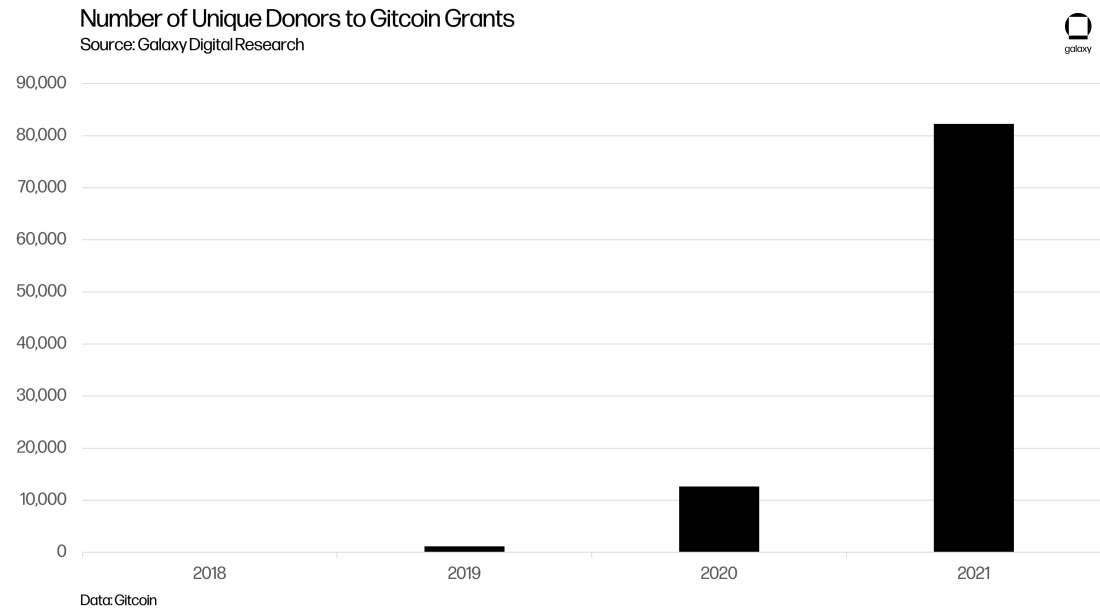
Starting with the giving trends for crypto to registered charities, the next section discusses donor activity and profiles in each of the two broad sectors of crypto donations over the last three years.
Donor Demographics
In general, crypto holders are predominantly young (below the age of 40) and skew male. According to a report by cryptocurrency exchange Gemini, the average per capita income for crypto holders in the U.S. is $111,000, which is roughly 2x higher than the average per capita income of the general population. Most of these characteristics are in sharp contrast to the traditional donor profile in the U.S. which is often older and less wealthy individuals.
Historically, the most archetypical crypto donors to registered charities have been Bitcoin holders. As the world’s oldest cryptocurrency, bitcoin is the most liquid and widely accepted crypto by merchants as a form of payment alongside fiat. Bitcoin also has the longest track record of appreciated gains and, therefore, has the widest holder base in profit who may seek to make use of deductions to offset their capital gains. For most institutional-focused giving platforms such as Fidelity Charitable, the majority of crypto donated on any given year is contributed in bitcoin.
However, on more retail-focused giving platforms, there has been a shift from predominantly BTC-denominated donations to ETH-denominated donations. The Giving Blocks reports that donations in ETH surpassed that of BTC for the first time in 2021. This is indicative of growing user adoption for alternative cryptocurrencies like ether among retail investors.
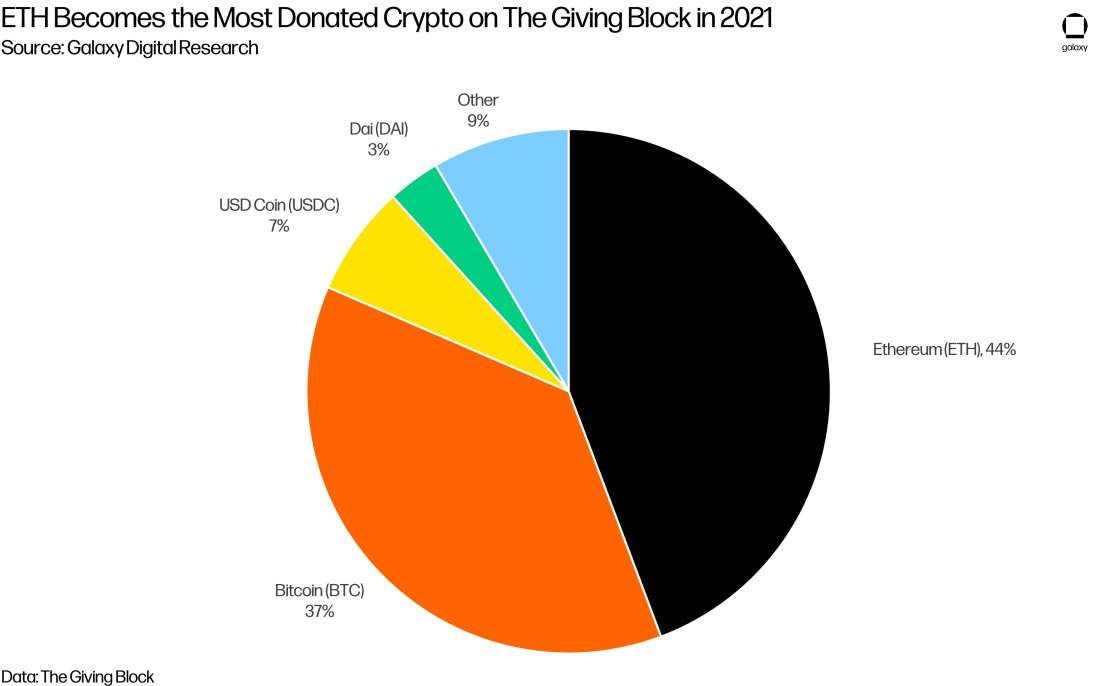
In 2021, Ethereum saw the highest year-over-year increase in number of on-chain accounts with a balance of at least $10 worth of ETH or more. Part of this surge in retail interest was driven by demand for non-fungible tokens (NFTs), many of which are minted and traded on Ethereum. As a tool for fundraising, NFTs have been used to raise over $12.3 million for charities in 2021. Charities such as Hope for Haiti and Trees for the Future have relied on proceeds from the sale of NFTs, which are typically denominated in ETH, to fund their operations and projects.
Retail adoption for Ethereum was also encouraged by the institutional adoption for the crypto asset in 2021. In February, the Chicago Mercantile Exchange launched their first regulated ether futures product for institutions and later in the year continued to expand its ether derivatives offerings by also launching micro ether futures. The maturation of risk management for ETH through options products propelled a record-breaking number of companies to hold the cryptocurrency on official corporate balance sheets. Companies such as Meitu, TIME Magazine, Mogo, and Paystand made investments in ETH for the first time in 2021. Looking at on-chain data, the number of accounts holding at least $1 million worth of ETH grew 14% and reached an all-time high of 102,728,507 in early November.

Profile of Donors Giving to Distributed Organizations
When it comes to crypto donations for the funding of decentralized organizations, donors typically contribute in smaller amounts through stablecoins, as opposed to ETH or BTC. The average donation size on Gitcoin is $18.85. Nearly 60% of all donations contributed on the platform in 2021 have been denominated in dollar-pegged stablecoins such as DAI, USDC and USDT.
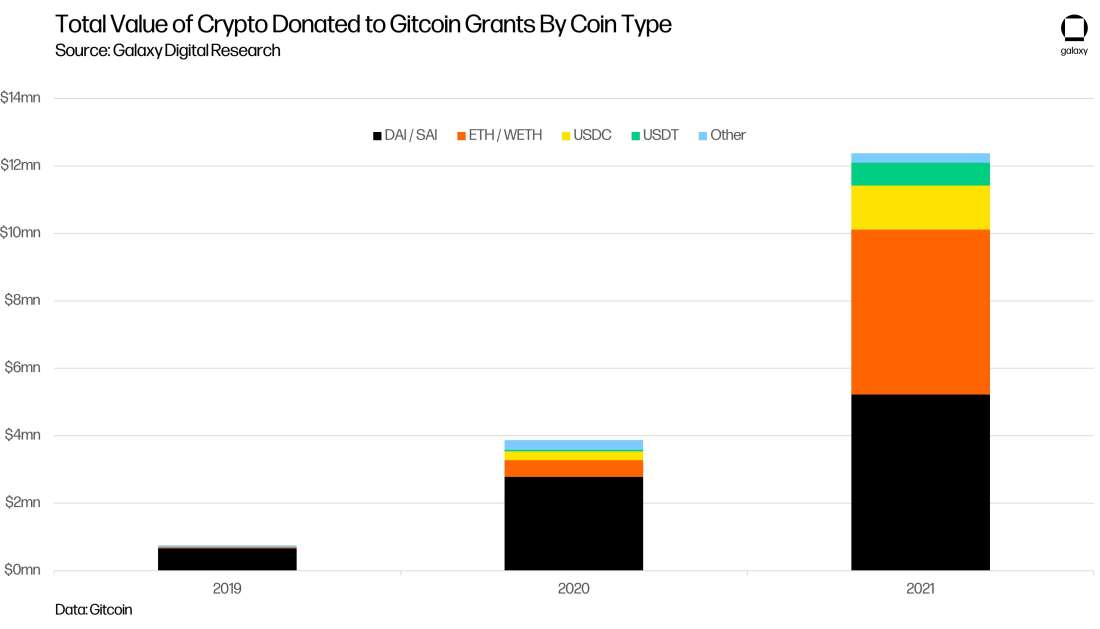
The work being funded is most often a set of technical tasks building a product that would benefit the growth and development of a decentralized blockchain. The most active funders of such public goods are cryptocurrency developers as opposed to investors or traders. Unlike donating to registered charities, the contributions made to open bounties and grants are usually not eligible for tax benefits. This is because funds are sent directly to an individual or group of individuals as opposed to a licensed charity.
Due to the ethos of the crypto industry, relying on a decentralized community for funding of public goods on a blockchain is not uncommon. For Bitcoin, which has no governing foundation or pre-mine to fund development, protocol development is funded through a variety of family offices, blockchain companies, independent developers, and non-profit organizations. Examples include Blockstream, Square, Gemini, Fidelity, and OKEx, as well as non-profits like MIT Digital Currency Initiative, BRINK, The Human Rights Foundation, and Chaincode Labs.
For other blockchains such as Ethereum and Solana, whose founders set aside funds at launch to help fund development, development is largely organized by a centralized foundation that manages and deploys funds raised for this purpose from an initial coin offering or VCs. One of the primary motivations for using platforms such as Gitcoin is to guide protocol development away from centralized foundations and sources of funding. By engaging members of the community directly to participate in financing the maintenance and upgrades for the protocol, a major goal of Gitcoin is to build up the long-term sustainability of public blockchains to last long after foundations close down and VC funds dry up.
Conclusion
The rise of charitable donations in cryptocurrencies over the past three years is a testament to the growing adoption of cryptocurrencies by the public. However, it also highlights the ways in which cryptocurrency donors are challenging the norms of charitable giving. Charities, non-profits, and NGOs are seeing influxes of donations from young, well-financed male professionals, which has historically been an underrepresented demographic for charitable giving in the U.S.
Philanthropic funding platforms such as Gitcoin and MolochDAO are experimenting with strategies and technologies to efficiently allocate donor resources in support of decentralized applications and protocols. Specifically, DAOs have been seeing a resurgence in recent years as a tool for social organization and coordination along with the rise of decentralized finance applications that are designed to automatically manage and generate yield for financial assets on Ethereum. Increased use of DAOs for facilitating philanthropy is one of the ways in which blockchain technology may prove to radically cut down on the operational costs of a traditionally underfunded sector like philanthropy through decentralization.
Looking ahead, the amount of donations in crypto for charity is likely to keep on growing as the number of active investors and holders of cryptocurrencies also increases. As the number of crypto donors rises, the number of charitable organizations that accept and ultimately hold cryptocurrencies as a viable source of funding will also grow. More donations made to more charities and non-profits is a great narrative boost for cryptocurrency payments, which have for years been derided for their use for illicit activity. As such, tracking the activity of crypto being donated to registered charities and public goods platforms will continue to be an important proxy for broader trends signaling growth and adoption in the crypto space.
Legal Disclosure:
This document, and the information contained herein, has been provided to you by Galaxy Digital Holdings LP and its affiliates (“Galaxy Digital”) solely for informational purposes. This document may not be reproduced or redistributed in whole or in part, in any format, without the express written approval of Galaxy Digital. Neither the information, nor any opinion contained in this document, constitutes an offer to buy or sell, or a solicitation of an offer to buy or sell, any advisory services, securities, futures, options or other financial instruments or to participate in any advisory services or trading strategy. Nothing contained in this document constitutes investment, legal or tax advice or is an endorsementof any of the digital assets or companies mentioned herein. You should make your own investigations and evaluations of the information herein. Any decisions based on information contained in this document are the sole responsibility of the reader. Certain statements in this document reflect Galaxy Digital’s views, estimates, opinions or predictions (which may be based on proprietary models and assumptions, including, in particular, Galaxy Digital’s views on the current and future market for certain digital assets), and there is no guarantee that these views, estimates, opinions or predictions are currently accurate or that they will be ultimately realized. To the extent these assumptions or models are not correct or circumstances change, the actual performance may vary substantially from, and be less than, the estimates included herein. None of Galaxy Digital nor any of its affiliates, shareholders, partners, members, directors, officers, management, employees or representatives makes any representation or warranty, express or implied, as to the accuracy or completeness of any of the information or any other information (whether communicated in written or oral form) transmitted or made available to you. Each of the aforementioned parties expressly disclaims any and all liability relating to or resulting from the use of this information. Certain information contained herein (including financial information) has been obtained from published and non-published sources. Such information has not been independently verified by Galaxy Digital and, Galaxy Digital, does not assume responsibility for the accuracy of such information. Affiliates of Galaxy Digital may have owned or may own investments in some of the digital assets and protocols discussed in this document. Except where otherwise indicated, the information in this document is based on matters as they exist as of the date of preparation and not as of any future date, and will not be updated or otherwise revised to reflect information that subsequently becomes available, or circumstances existing or changes occurring after the date hereof. This document provides links to other Websites that we think might be of interest to you. Please note that when you click on one of these links, you may be moving to a provider’s website that is not associated with Galaxy Digital. These linked sites and their providers are not controlled by us, and we are not responsible for the contents or the proper operation of any linked site. The inclusion of any link does not imply our endorsement or our adoption of the statements therein. We encourage you to read the terms of use and privacy statements of these linked sites as their policies may differ from ours. The foregoing does not constitute a “research report” as defined by FINRA Rule 2241 or a “debt research report” as defined by FINRA Rule 2242 and was not prepared by Galaxy Digital Partners LLC. For all inquiries, please email [email protected]. ©Copyright Galaxy Digital Holdings LP 2022. All rights reserved.



